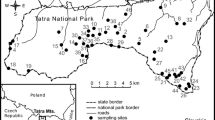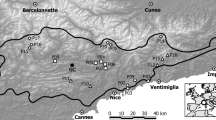Abstract
Environmental gradients in alpine systems may lead to differences in both abiotic conditions and species interactions in very short distances. This may lead to reproductive and phenotypic changes in plants to enhance fitness in each environment. In this study, we explored how the Central Andean Viola maculata responds to the elevation gradient, where it is distributed, with an expected increase in water availability and a decrease in pollinator availability with elevation. We hypothesized that: (1) plants would be more water-stressed at low elevations; (2) investment in and success of cleistogamous flowers (closed, self-pollinated) would increase with elevation; and (3) correlation patterns between floral and vegetative traits would vary along the gradient according to changes in biotic/abiotic selection pressures across sites. We partially confirmed the inverse gradient of water stress with elevation, with V. maculata populations in the lowest site experiencing lower soil moisture and showing thicker leaves and lower stomatal conductance. Cleistogamy was more prevalent and successful at the highest site, thus confirming the hypothesis of maintenance of a mixed-mating system as reproductive assurance. Correlation patterns between flower and leaf size differed across sites, with stronger vegetative–floral correlation at the lower sites and a weak correlation at the highest site. This finding disagrees with the notion of pollinators as drivers of correlation between floral and vegetative traits. Our study shows how a narrow gradient in an alpine system may affect not only reproductive and physiological responses in plants, but also floral and vegetative covariances.



Similar content being viewed by others
References
Albert LP, Campbell LG, Whitney KD (2011) Beyond simple reproductive assurance: cleistogamy allows adaptive plastic responses to pollen limitation. Int J Plant Sci 172:862–869
Armbruster W, Di Stilio VS, Tuxill JD et al (1999) Covariance and decoupling of floral and vegetative traits in nine neotropical plants: a re-evaluation of Berg’s correlation-pleiades concept. Am J Bot 86:39–55
Arroyo MTK, Squeo F (1990) Relationship between plant breeding systems and pollination. Academic, London
Arroyo MTK, Armesto JJ, Primack RB (1985) Community studies in pollination ecology in the high temperate Andes of central Chile II. Effect of temperature on visitation rates and pollination possibilities. Plant Syst Evol 149:187–203
Arroyo MTK, Muñoz MS, Henríquez C, Till-Bottraud I, Pérez F (2006) Erratic pollination, high selfing levels and their correlates and consequences in an altitudinally widespread above-tree-line species in the high Andes of Chile. Acta Oecologica 30:248–257
Berg RL (1960) The ecological significance of correlation pleiades. Evol Int J Org Evol 14:171–180
Brock M, Weinig C (2007) Plasticity and environment-specific covariances: an investigation of floral-vegetative and within flower correlations. Evol Int J Org Evol 61:2913–2924
Carlson JE, Adams CA, Holsinger KE (2016) Intraspecific variation in stomatal traits, leaf traits and physiology reflects adaptation along aridity gradients in a South African shrub. Ann Bot 117(1):195–207
Carroll AB, Pallardy SG, Galen C (2001) Drought stress, plant water status, and floral trait expression in fireweed, Epilobium angustifolium (Onagraceae). Am J Bot 88:438–446
Caruso C (2006) Plasticity of inflorescence traits in Lobelia siphilitica (Lobeliaceae) in response to soil water avalability. Am J Bot 93:531–538
Carvallo GO, Medel R (2010) Effects of herkogamy and inbreeding on the mating system of Mimulus luteus in the absence of pollinators. Evol Ecol 24:509–522
Carvallo GO, Medel R, Navarro L (2013) Assessing the effects of native plants on the pollination of an exotic herb, the blueweed Echium vulgare (Boraginaceae). Arthropod Plant Interact 7:475–484
Cavieres LA, Badano EI, Sierra-Almeida A, Gómez-González S, Molina-Montenegro MA (2006) Positive interactions between alpine plant species and the nurse cushion plant Laretia acaulis do not increase with elevation in the Andes of central Chile. New Phytol 169:59–69
Cheverud J (1988) A comparison of genetic and phenotypic correlations. Evol Int J org Evol 42:958–968
Conner JK, Sterling A (1996) Selection for independence of floral and vegetative traits: evidence from correlation patterns in five species. Can J Bot 74:642–644
Conner JK, Via S (1993) Patterns ofphenotypic and genetic correlations among morphological and life-history traits in wild radish, Raphanus raphanistrum. Evolution 47:704–711
Culley TM (2002) Reproductive biology and delayed selfing in Viola pubescens (Violaceae), an understory herb with chasmogamous and cleistogamous flowers. Int J Plant Sci 163:113–122
Di Castri F, Hajek E (1976) Bioclimatología de Chile. Ediciones de la Pontificia Universidad Católica de Chile, Santiago
Flury B (1988) Common principal components and related multivariate models. Wiley, New York, NY
Galen C (2000) High and dry: drought stress, sex-allocation trade-offs, and selection on flower size in the alpine wildflower Polemonium viscosum (Polemoniaceae). Am Nat 156:72–83
Germino MJ, Smith WK (2000) High resistance to low-temperature photoinhibition in two alpine, snowbank species. Physiol Plant 110:89–95
Gianoli E (2004) Plasticity of traits and correlations in two populations of Convolvulus arvensis (Convolvulaceae) differing in environmental heterogeneity. Int J Plant Sci 165:825–832
Gianoli E, Palacio-López K (2009) Phenotypic integration may constrain phenotypic plasticity in plants. Oikos 118:1924–1928
Gianoli E, Valladares F (2012) Studying phenotypic plasticity: the advantages of a broad approach. Biol J Linn Soc 105:1–7
Hamann E, Scheepens JF, Kesselring H, Armbruster GFJ, Stöcklin J (2017) High intraspecific phenotypic variation, but little evidence for local adaptation in Geum reptans populations in the Central Swiss Alps. Alp Bot 127:121–132
Harrell Jr FE, Dupont C, et al (2017) Hmisc: Harrell Miscellaneous. R package version 4.0-2
Hernández-Fuentes C, Bravo LA, Cavieres LA (2015) Photosynthetic responses and photoprotection strategies of Phacelia secunda plants exposed to experimental warming at different elevations in the central Chilean Andes. Alpine Botany 125:87–99
Herrera J (2005) Flower size variation in Rosmarinus officinalis: individuals, populations and habitats. Ann Bot (Lond) 95:431–437
Herrera CM, Medrano M, Rey PJ et al. (2002) Interaction of pollinators and herbivores on plant fitness suggests a pathway for correlated evolution of mutualism- and antagonism-related traits. Proc Natl Acad Sci USA 99:16823–16828
Hetherington AM, Woodward FI (2003) The role of stomata in sensing and driving environmental change. Nature 424:901–908
Hijmans RJ, Van Etten J (2012) Raster: geographic analysis and modeling with raster data. R package version 2.0–12.
Körner C (2003) Alpine plant life. Springer, Berlin
Körner C (2007) The use of “altitude” in ecological research. Trends Ecol Evol 22:569–574
Lambrecht SC, Dawson TE (2007) Correlated variation of floral and leaf traits along a moisture availability gradient. Oecologia 151:574–583
Lázaro A, Santamaria L (2016) Flower-visitor selection on floral integration in three contrasting populations of Lonicera implexa. Am J Bot 103:1–12
Lázaro A, Totland O (2014) The influence of floral symmetry, dependence on pollinators and pollination generalization on flower size variation. Ann Bot (Lond) 114:157–165
Lázaro-Nogal A, Matesanz S, Godoy A et al (2015) Environmental heterogeneity leads to higher plasticity in dry-edge populations of a semi-arid Chilean shrub: insights into climate change responses. J Ecol 103:338–350
Leimu R, Fischer M (2008) A meta-analysis of local adaptation in plants. PLoS One 3:e4010
Lenth RV (2016) Least-squares means: the R package lsmeans. J Stat Softw 69:1–33
Loik ME, Redar SP (2003) Microclimate, freezing tolerance, and cold acclimation along an elevation gradient for seedlings of the Great Basin Desert shrub, Artemisia tridentata. J Arid Environ 54:769–782
Lovett Doust L (1981) Population dynamics and local specialization in a clonal perennial (Ranunculus repens): I. The dynamics of ramets in contrasting habitats. J Ecol 69:743–755
Maxwell K, Johnson GN (2000) Chlorophyll fluorescence—a practical guide. J Exp Bot 51:659–668
Milla R, Giménez-Benavides L, Escudero A, Reich PB (2009) Intra- and interspecific performance in growth and reproduction increase with altitude: a case study with two Saxifraga species from northern Spain. Funct Ecol 23:111–118
Muñoz AA, Celedon-Neghme C, Cavieres LA, Arroyo MTK (2005) Bottom-up effects of nutrient availability on flower production, pollinator visitation, and seed output in a high-Andean shrub. Oecologia 143:126–135
Pélabon C, Osler NC, Diekmann M, Graae BJ (2013) Decoupled phenotypic variation between floral and vegetative traits: distinguishing between developmental and environmental correlations. Ann Bot (Lond) 111:935–944
Phillips P, Arnold S (1999) Hierarchical comparison of genetic variance-covariance matrices. I using the Flury hierarchy. Evolution 53:1506–1515
Pigliucci M (2003) Phenotypic integration: studying the ecology and evolution of complex phenotypes. Ecol Lett 6:265–272
Ramírez-Valiente JA, Sánchez-gómez D, Aranda I, Valladares F (2010) Phenotypic plasticity and local adaptation in leaf ecophysiological traits of 13 contrasting cork oak populations under different water availabilities. Tree Physiol 30:618–627
Ramos-Jiliberto R, Domínguez D, Espinoza C et al (2010) Topological change of Andean plant-pollinator networks along an altitudinal gradient. Ecol Complex 7:86–90
Redbo-Torstensson P, Berg H (1995) Seasonal cleistogamy: a conditional strategy to provide reproductive assurance. Acta Botanica Neerlandica 44:247–256
Schilichting CD (1989) Phenotypic plasticity in Phlox. II. Plasticity of character correlations. Oecologia 78:496–501
Schoen DJ, Lloyd DG (1984) The selection of cleistogamy and heteromorphic diaspores. Biol J Linn Soc 23:303–322
Strauss SY, Whittall JB (2006) Non-pollinator agents of selection on floral traits. In: Ecology and evolution of flowers. Oxford Biology, pp 120–138
Suárez L, Gonzáles W, Gianoli E (2009) Foliar damage modifies floral attractiveness to pollinators in Alstroemeria exerens. Evol Ecol 23:545–555
Totland Ø (1997) Limitations on reproduction in alpine Ranunculus acris. Can J Bot 75:137–144
Totland Ø, Eide W (1999) Environmentally-dependent pollen limitation on seed production in alpine Ranunculus acris. Ecoscience 6:173–179
von Wettberg EJ, Huber H, Schmitt J (2005) Interacting effects of microsite quality, plasticity and dispersal distance from the parental site on fitness in a natural population of Impatiens capensis. Evol Ecol Res 7:531–548
Wagner G (1984) On the eigenvalue distribution of genetic and phenotypic dispersion matrices: evidence for a nonrandom organization of quantitative character variation. J Math Biol 21:77–95
Waitt DE, Levin DA (1993) Phenotypic integration and plastic correlations in Phlox drummondii (Polemoniaceae). Am J Bot 80:1224–1233
Wang R, Yu G, He N et al (2014) Elevation-related variation in leaf stomatal traits as a function of plant functional type: evidence from Changbai Mountain, China. PLoS One 9:1–15
Zuur AF, Leno EN, Walker NJ, Saveliev AA, Smith GM (2009) Mixed effects models and extensions in ecology with R. Springer, New York
Acknowledgements
The work was supported by a pre-doc fellowship from the Balearic Island Government (FPI/1509/2012), co-financed by the European Social Fund (ESF). Funding was provided by the International Laboratory of Global Change (LINCGlobal) and by the Ibero-American Young Research’s grants (Santander). We thank Fernando Valladares, for his valuable support for the study to go forward, and Fernanda Pérez, Iñaki Azua, Isidora Sepulveda, Alejandro Dias, and Patricio Andes Valenzuela for their valuable support in the field. Thanks to Yulinka Alcayaga and Mónica Cisternas for their valuable support processing data in the lab. We also thank the staff at National Reserve Altos de Lircay for their help in the field.
Author information
Authors and Affiliations
Contributions
JS and EG conceived and designed the project. JS and CSL collected the data. JS and AL analyzed the data. JS, EG, AT and AL wrote the manuscript.
Corresponding author
Ethics declarations
Conflict of interest
The authors declare that they have no conflict of interest.
Electronic supplementary material
Below is the link to the electronic supplementary material.
35_2017_195_MOESM1_ESM.tif
Images of the habitat and co-occurring plant species at each site. Viola maculata co-occurs mainly by Chusquea coleou and Festuca pallescens at 1950 m, with Mulinum echinus and Berberis empetrifolia at 2200 m, and with Festuca pallescens and Berberis empetrifolia at 2350 m (TIF 27902 KB)
35_2017_195_MOESM2_ESM.tif
Phenology recorded between December 27th and December 29th 2014. Bars represent the percentage of floral buds, opened flowers, developing fruits, and fruits present in each population in those dates (TIF 125 KB)
35_2017_195_MOESM3_ESM.tif
Schematic drawing of a Viola maculata leaf and associated CH flower, illustrating the different plant traits examined in this study (TIF 401 KB)
Rights and permissions
About this article
Cite this article
Seguí, J., Lázaro, A., Traveset, A. et al. Phenotypic and reproductive responses of an Andean violet to environmental variation across an elevational gradient. Alp Botany 128, 59–69 (2018). https://doi.org/10.1007/s00035-017-0195-9
Received:
Accepted:
Published:
Issue Date:
DOI: https://doi.org/10.1007/s00035-017-0195-9




